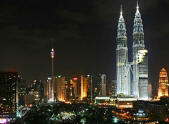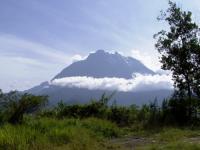Chinese Culture >> Travel Reviews and Photos >> Malaysia Guide
Malaysia Guide
Despite its recent economic crisis, Malaysia continues to careen along the fast track of development. For visitors, this means that Malaysia is a comfortable country to explore, as the roads are smooth, public transportation is good, and familiar comforts abound in all but the smallest of kampungs (villages).
For centuries, Malaysia has been a crossroads for trade in materials, traditions, and ideas. The region was originally settled by the Orang Asli people and migrants from southern China; Indian traders subsequently spread their cultural and religious traditions throughout the area. Islam took root there during the 15th century, when Prince Sri Paremeswara--who founded the empire of Melaka--became a Muslim after marrying a Sumatran ruler's daughter. In 1511, the Portuguese invaded Melaka, only to lose power to the Dutch in the late 1600s. The Dutch maintained control of the region for almost three centuries, until the Anglo-Dutch Treaty of 1874 ceded the Malaysian kingdom states to the British. On August 31, 1957, the Peninsula was granted independence as the Federated States of Malaya. Singapore, Sabah, and Sarawak joined the Federated States of Malaya, which became Malaysia in 1963. Then Singapore assumed independence in 1965, leaving the peninsula, Sabah, and Sarawak as the Malaysia that remains today.

Travelers seeking both relaxation and the stimulation of a different culture will find that Malaysia offers the perfect mix of serene coastline and spicy street life. Though Malaysia's beaches are not the most spectacular in Southeast Asia, stretches of coastline on the peninsula's east coast, as well as on islands such as Pangkor and the Pehrentians, offer seaside seclusion that is difficult to find in other parts of the world. Away from the lapping tides, the streets of Georgetown and Kuala Lumpur pulse with the energy of big-city life. Open-air markets attract throngs of people seeking fresh fruit and vegetables. Hawkers at sidewalk stalls dish out tasty pan-fried food like nasi kandar (curry rice) and ormee goreng (spicy noodles). There is also a spiritual flavor to the city streets--Islamic mosques stand beside Hindu and Buddhist temples, bearing testimony to the intertwined history of these Eastern religions.
Malaysia is a country on the move. Its official mission is to become industrialized by the year 2020. But despite the rapid pace of its growth, Malaysia will likely keep its welcoming atmosphere, as the warmth of the people is as unchanging as the tropical weather. The population is a diverse mix of ethnic Malay (58 percent), Chinese (26 percent), and southern Indian (eight percent). Though tensions exist, fomented by blatantly pro-Malay policies enacted by the majority government, interactions among ethnic groups remain remarkably open and peaceful.
Cameron Highlands
The Cameron Highlands is a lush area of mountaintop jungle in a remote corner of Pahang State. It's easy to see why the British chose this spot for retreat--the temperature is ten degrees cooler than low-lying Kuala Lumpur, and the landscape is an enchanting patchwork of rolling jungle and terraced plantations. There are three towns in the Cameron Highlands: Ringlet, Tanah Rata, and Brinchang. Tanah Rata is the main town, and it offers hostels and mid-scale hotels, as well as many restaurants and shops. Trails snake for miles through the jungle, leading to breathtaking mountaintop vistas and cascading waterfalls.
Cherating
Cherating lies off a quiet stretch of highway about 12 miles (20km) north of Kuantan. Hiding behind ramshackle restaurants is a beautiful half-moon beach, one of the most dazzling beaches on the peninsula. This is one of the top 10 windsurfing spots in the world, and every afternoon the ocean is dotted with colorful sails flapping in the breeze. Inexpensive but comfortable cabanas cluster in the shade of palm trees at the edge of the beach. Club Med owns a gorgeous section of coast a little more than a mile (2km) away from Cherating's main beach.
Kuala Lumpur
 The bustling capital of Malaysia, Kuala Lumpur is proof of the
country's movement into the industrialized world. KL (as it is commonly dubbed)
received a citywide facelift for the 1998 Commonwealth Games, and since then the
capital has boasted a buffed atmosphere of almost Singaporean standards.
Travelers should see the Petronas Towers (the tallest buildings in the world),
stroll in Merdeka Square, visit the elegant marble Masjid Jamek (a lovely mosque
in the center of the city), and enjoy the booming nightlife in a city rivaling
Singapore as a hotspot for clubs and bars.
The bustling capital of Malaysia, Kuala Lumpur is proof of the
country's movement into the industrialized world. KL (as it is commonly dubbed)
received a citywide facelift for the 1998 Commonwealth Games, and since then the
capital has boasted a buffed atmosphere of almost Singaporean standards.
Travelers should see the Petronas Towers (the tallest buildings in the world),
stroll in Merdeka Square, visit the elegant marble Masjid Jamek (a lovely mosque
in the center of the city), and enjoy the booming nightlife in a city rivaling
Singapore as a hotspot for clubs and bars.
Langkawi
The big island of Langkawi is one of 99 islands in the Langkawi group that cluster off the northwest coast near the border with Thailand. More so than perhaps anywhere else in Malaysia, Langkawi exhibits extremes in untouched landscapes and developed coastline. The island is lovely to drive around. There are many pristine beaches and waterfalls to see, as well as fishing kampungs (villages) and magnificent caves to explore. Because of its remote locale and relatively large size, those who stay for at least two full days best enjoy Langkawi.
Melaka
Whereas Kuala Lumpur is the Malaysia of the present and the future, Melaka is the Malaysia of the past. A virtual living museum, the old town makes for a pleasant stroll past crimson buildings in the Dutch square, around vendors hawking local handicrafts, and through the narrow alleyways of Chinatown. There are many fascinating museums housed in the old Dutch government buildings. The ruins of a Portuguese-Catholic-cum-British-Protestant church surrounded by Dutch tombstones is testimony to Malaysia's checkered colonial past. This is a good place to try nyonya food, a spicy blend of Chinese and Malay cooking.
Mount Kinibalu
Mount Kinabalu is located in the northern region of Sabah, on the island of Borneo. Kinibalu is Southeast Asia's tallest mountain, peaking at 13,451 feet (4,101m) above sea level and rising every year. Untouched jungle-covered mountain slopes surround Kinabalus' granite core; a breathtaking setting typifying many travelers' ideals of tropical Southeast Asia. Climbing to the Kinabalu summit is no small feat, and should be attempted by only those who are fit and prepared.
Penang
Though Penang's beaches are arguably the least interesting of all of Malaysia's island beaches, the island remains a highlight because of its combination of lovely coastline and the bustling cultural center of Georgetown. Georgetown is a feast for all senses. Open-air markets, congregations of food hawkers, and throngs of pedestrians and motorbikes are sure to excite young and old. The resorts at Batu Ferringhi offer an antidote to the Georgetown racket. The luxury hotels that line the northeastern coast of Penang are a perfect beachfront destination for those who like convenience and creature comforts.
Perhentian Islands
Pulau Perhentian Kecil (Small Island) and Pulau Perhentian Besar (Big Island) are located about 12 miles (20km) off the northeast coast of the peninsula. These isles are the perfect getaway destination for those who are willing to sacrifice resort-style luxury for solitude and pristine stretches of sand. The Small Island is famous for Long Beach, where the sand is wide and white and the water is ideal for swimming. The Big Island is less popular (though the west coast attracts young divers) and therefore offers more seclusion.
Pulau Pangkor
Pangkor is a small island off the west coast that is located roughly equidistant from Penang and Kuala Lumpur. In size and atmosphere, Pangkor is like Penang's and Langkawi's little sibling. The island is small enough to drive around in half an hour. Its compact nature lends the isle a charm conducive to relaxation. Pangkor's smallness also precludes monotonous strips of resort development, allowing for the simple enjoyment of sun, surf, and sand. The Pan Pacific Resort offers luxury accommodations and water sports on Golden Sands Beach; there are also mid-market hotels at Pantai Pasir Bogak and budget cabanas at Teluk Nipah.
Taman Negara
Taman Negara National Park, located in the center of the peninsula, is one of the last remaining areas of indigenous rain forest on the peninsula. Though the larger animals, such as elephants, tigers, rhinos, and leopards, rarely venture near the developed parts of the park, there are plenty of magnificent birds to be seen. The most convenient place to stay is the Taman Negara Resort, which runs a ferry service from Kuala Tahan. There are guided treks and a canopy walk that allows visitors to see the forest from planks suspended above the treetops.
Tioman
Though Tioman's land is becoming overcrowded, its waters are still a diver's paradise. The azure-blue waters are clear to a depth of more than 10 yards (or meters). Diving and snorkeling excursions depart from Kumpung Tekek and Kampung Salang. Those who simply want a peaceful retreat will find lovely chalets on stilts at Kumpung Air Batang (Bamboo Hill Chalets) and more isolated accommodations at the Juara Bay Resort, cut into the hills at Kampung Juara.
Top Cities in Malaysia
Kuala Lumpur - Penang - Langkawi - Kota Kinabalu - Georgetown - Kuantan - Malacca - Johor Bahru - Kuching - Petaling Jaya - Cameron Highlands - Kuala Terengganu - Kota Bharu - Subang Jaya - Fraser's Hill
About the Author:
Alix Sunggin is Webmaster: Business Health Articles ( http://www.businesshealtharticles.com ) Malaysia Travel Agent ( http://www.malaysiatravelagent.com.my ) eBook Profit Package (http://www.ebookprofitpackage.com)
